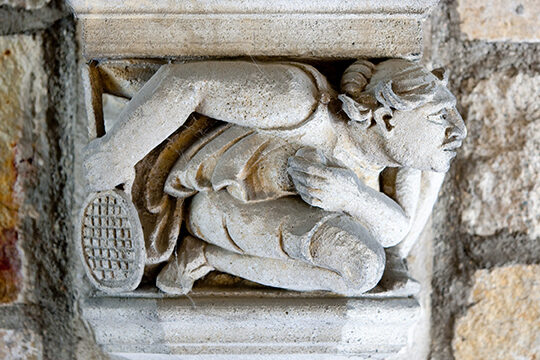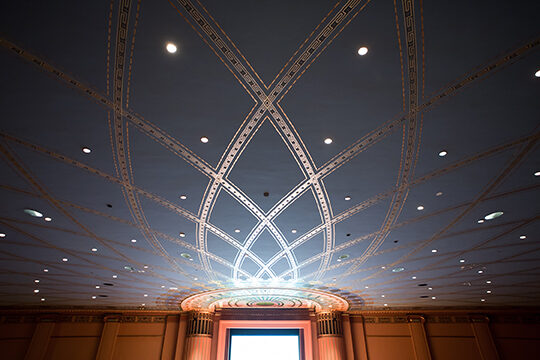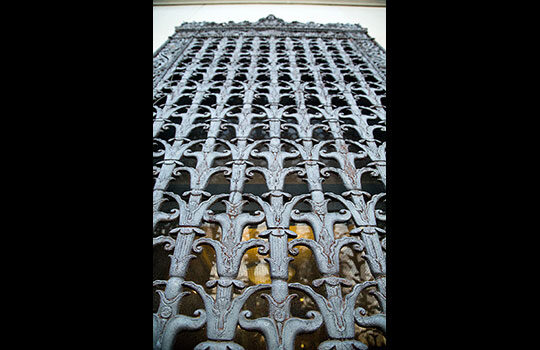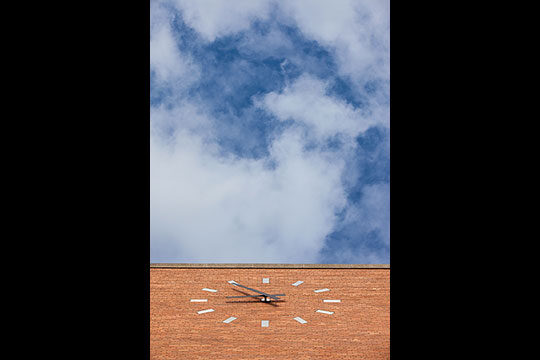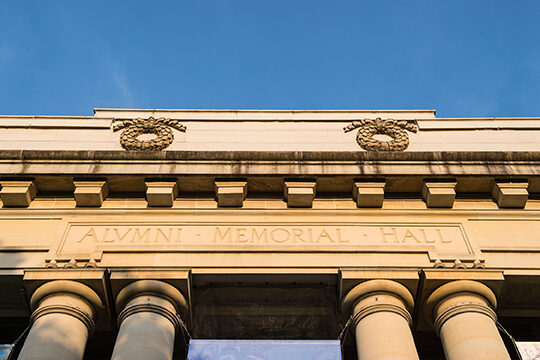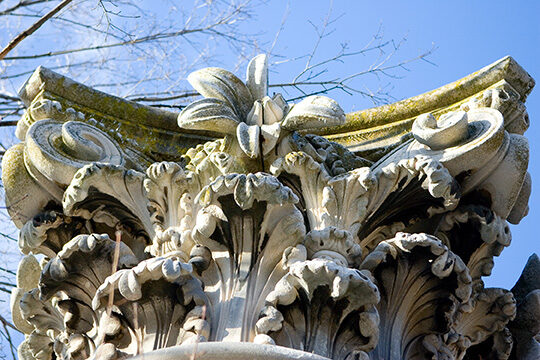Opening of the eyes
From stone-faced gargoyles to elaborate ceiling designs, U-M’s hallowed halls of learning offer countless visual delights. All of these images come from the talented team at Michigan Photography.
-
Eyes on the prize
New York-based artist Ulysses Ricci (1888-1960) sculpted the “Boweryesque” corbels peering out from countless nooks and crannies at the Michigan Law School Quad. He was a partner in the firm Ricci & Zari from 1917-41. Six large corbels in the center passage represent the first six U-M presidents: Henry Tappan, Erastus Haven, Henry Frieze, Harry Hutchins, James Angell, and Marion Burton. Other corbels throughout the Quad represent various arts, sciences, and professions. Athletics also gets its due, as we see here. (Image: Scott C. Soderberg, Michigan Photography.) More
-
Art deco extravaganza
The Rackham Building is one of the most beautiful spaces on the Michigan campus. Its focal point is the 1,200-seat lecture hall on the main floor. The ceiling features a spectacular intertwining gold-leaf pattern that converges over the stage. The room also has one of the earliest uses of recessed lighting, a reflection by architect William E. Kapp’s sensitivity to lighting design. Builders broke ground for Rackham in May 1936; the building was officially dedicated in June 1938. (Image: Austin Thomason, Michigan Photography.) More
-
Metal works
While the pumas outside the University of Michigan Museum of Natural History get most of the attention from passersby, this decorative metal work on the building’s exterior is worthy of an admiring look. The museum’s collections were established in the mid-19th century and grew in significance with the donation of more than 60,000 specimens by world-traveling alumnus Joseph Beal Steere in the 1870s. (Image: Scott C. Soderberg, Michigan Photography.) More
-
Angell and the arts
Flanking the main stairs of Angell Hall are four bas reliefs by Ulysses Ricci with symbols of poetry, history, philosophy and art (pictured here). Ricci’s work can be seen throughout the Law Quad; he also is credited with the medallions on the façade of Hatcher Library, and the bas reliefs on the C.C. Little Building. Angell Hall is inscribed with words from the Northwest Ordinance of 1787: “Religion, morality, and knowledge, being necessary to good government and the happiness of mankind, schools and the means of education shall forever be encouraged.” (Image: Marcia Ledford, Michigan Photography.) More
-
Good times
While most of us carry a clock in the form of a cell phone, this friendly face atop the College of Literature, Science, and the Arts Building helps keep the University community on schedule. Some 200,000 living Michigan graduates hold degrees from LS&A, which was founded in 1841. (Image: Austin Thomason, Michigan Photography.) More
-
Go to nature
Visitors to the Alexander G. Ruthven Museums Building — now commonly known as the U-M Exhibit Museum — are advised to look up as they enter. In addition to this elaborate stone work over the building’s entrance, the facade bears the following inscription, credited to noted biologist and geologist Louis Agassiz (1807-73): “Go to nature. Take the facts into your own hands. Look and see for yourself.” (Image: Scott C. Soderberg, Michigan Photography). More
-
Caught in a web
This skylight in the atrium of Stockwell Hall is akin to a beautiful glass spiderweb. The residence hall is named after Madelon Louisa Stockwell, the first woman to be admitted to the University of Michigan. Doors opened in 1940, and extensive renovations were completed in 2009. (Image: Martin Vloet, Michigan Photography.) More
-
The Dude
These columns welcome visitors to the James and Anne Duderstadt Center on North Campus. Designed by Albert Kahn Associates of Detroit, the building opened its doors in 1996.The Duderstadt Center houses the Art, Architecture, and Engineering Library, the College of Engineering Computer Aided Engineering Network (CAEN), the Digital Media Commons, and the Millennium Project. It also offers student access to 3D and virtual reality labs, among other state-of-the-art production facilities. (Image: Scott C. Soderberg, Michigan Photography.) More
-
Beaux-Arts
Alumni Memorial Hall was born of a desire to honor University men who’d fallen during the Civil War. Detroit architects Donaldson and Meier designed the building, which was completed in 1910, at the corner of State Street and South University Avenue. Today, the building is part of the University of Michigan Museum of Art. (Image: Austin Thomason, Michigan Photography.) More
-
Eastern influence
After a yearlong renovation, East Quad reopened for the 2013 fall term with new infrastructure including plumbing, electrical, heating, and more. Fortunately details like this charming window remained intact. About 850 Michigan students call East Quad home at any given time. The building houses the Residential College and the Gender-Inclusive Living Experience. (Image: Scott C. Soderberg, Michigan Photography.) More
-
The Lorch Column
Acquired through the efforts of Emil Lorch, this Corinthian column was made for the home office building of the Mutual Benefit Life Insurance Company of Newark, N.J., but was never installed. It was a gift to U-M by Colonel William Starrett, class of 1897. The truncated column was originally installed in the courtyard of Lorch Hall, the first home of the College of Architecture. It’s now installed at North Campus near the Taubman College of Architecture and Urban Planning. The column is mounted on a tall base with a steel element inserted to raise it to its intended height — had it been installed on a building. (Image Scott R. Galvin, Michigan Photography.) More

